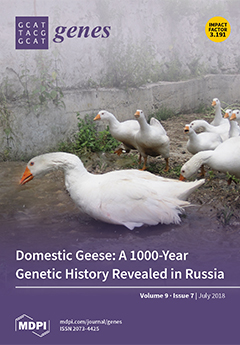GADD45B acts as a member of the growth arrest DNA damage-inducible gene family, which has demonstrated to play critical roles in DNA damage repair, cell growth, and apoptosis. This study aimed to explore the potential relationship between
GADD45B expression and tumor progression and
[...] Read more.
GADD45B acts as a member of the growth arrest DNA damage-inducible gene family, which has demonstrated to play critical roles in DNA damage repair, cell growth, and apoptosis. This study aimed to explore the potential relationship between
GADD45B expression and tumor progression and evaluate the clinical value of
GADD45B in stage II colorectal cancer (CRC). The expression patterns and prognostic value of
GADD45B in CRC were analyzed based on The Cancer Genomic Atlas (TCGA).
GADD45B expression features of 306 patients with stage II CRC and 201 patients with liver metastasis of CRC were investigated using immunochemical staining on tissue microarrays. Afterward, survival analysis and stratification analysis were performed in stage II to explore the prognostic and predictive significance of
GADD45B. Overexpressed
GADD45B is associated with poorer prognosis for CRC patients both in overall survival (OS) (
p < 0.001) and disease-free survival (DFS) (
p = 0.001) based on the TCGA database. Analysis results according to the stage II CRC cohort and the liver metastatic CRC cohort revealed that
GADD45B was gradually upregulated in normal mucosa including primary colorectal cancer (PCC). Colorectal liver metastases (CLM) tissues were arranged in order (normal tissue vs. PCC
p = 0.005 and PCC vs. CLM
p = 0.001). The low
GADD45B group had a significantly longer five-year OS (
p = 0.001) and progression-free survival (PFS) (
p < 0.001) than the high
GADD45B group for the stage II patients. The multivariate Cox regression analysis results proved that the expression level of
GADD45B was an independent prognostic factor for stage II after radical surgery (OS: Hazard Ratio (HR) 0.479, [95% confidence interval (CI) 0.305–0.753] and PFS:HR 0.490, [95% CI 0.336–0.714]). In high
GADD45B expression subgroup of stage II cohort, the patients who underwent adjuvant chemotherapy had longer PFS than those who did not (
p = 0.008). High expression levels of
GADD45B is an independent prognostic factor of decreased OS and PFS in stage II CRC patients. The stage II CRC patients with high
GADD45B expression might benefit from adjuvant chemotherapy.
Full article






